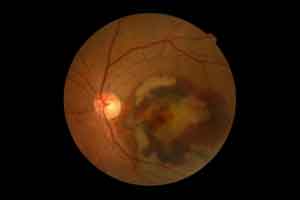- Home
- Editorial
- News
- Practice Guidelines
- Anesthesiology Guidelines
- Cancer Guidelines
- Cardiac Sciences Guidelines
- Critical Care Guidelines
- Dentistry Guidelines
- Dermatology Guidelines
- Diabetes and Endo Guidelines
- Diagnostics Guidelines
- ENT Guidelines
- Featured Practice Guidelines
- Gastroenterology Guidelines
- Geriatrics Guidelines
- Medicine Guidelines
- Nephrology Guidelines
- Neurosciences Guidelines
- Obs and Gynae Guidelines
- Ophthalmology Guidelines
- Orthopaedics Guidelines
- Paediatrics Guidelines
- Psychiatry Guidelines
- Pulmonology Guidelines
- Radiology Guidelines
- Surgery Guidelines
- Urology Guidelines
Long term use of Elmiron linked to retinal damage, finds new research

Bladder drug Elmiron or pentosan polysulfate sodium has been linked to retinal damage, according to new research.The study shows about a quarter of patients with significant exposure to the drug show signs of retinal damage.However if identified early, the damage may be mitigated by stopping the medication.The research will be presented today at AAO 2019, the 123nd Annual Meeting of the American Academy of Ophthalmology.
Elmiron is the only FDA-approved pill to treat Interstitial cystitis, that affects more than 1 million people in the United States, mostly women.The drug has been widely prescribed for this bladder condition for decades.
The ophthalmologists conducted a review of patients at Kaiser Permanente in Northern California after an initial report last year that Elmiron (pentosan polysulfate sodium) may be associated with retinal damage.
They found that about one-quarter of patients with significant exposure to Elmiron showed definite signs of eye damage, and that this medication toxicity could masquerade as other known retinal conditions, such as age-related macular degeneration or pattern dystrophy.
Last year, Nieraj Jain, M.D., of Emory Eye Center in Atlanta, Ga., reported that six patients who had been taking Elmiron for about 15 years had developed unusual changes in their macula, the central part of the retina responsible for delivering clear, crisp, central vison. Because nothing in the patients' medical history or diagnostic tests explained the subtle, but striking pattern of abnormalities, Dr. Jain and his colleagues raised a warning flag that long-term use of Elmiron may damage the retina.
Robin A. Vora, M.D , Amar P. Patel, M.D., and Ronald Melles M.D., ophthalmologists at Kaiser Permanente, heeded that warning and looked at their population of patients. They initially found one woman on long-term treatment who was misdiagnosed as having a retinal dystrophy. This worrisome case prompted them to examine Kaiser's entire database of 4.3 million patients.
They found 140 patients who had taken an average of 5,000 pills each over the course of 15 years. Of those 140 patients, 91 agreed to come in for an exam. Drs. Vora, Patel, and Melles took detailed images of the back of their eyes and then divided the images into three categories: normal, possible abnormality, definite abnormality. Twenty-two of the 91 patients showed clear signs of drug toxicity. The rate of toxicity rose with the amount of drug consumed, from 11 percent of those taking 500 to 1,000 grams to 42 percent of those taking 1,500 grams or more.
"It's unfortunate," said Dr. Vora. "You have a patient with a chronic condition like interstitial cystitis, for which there is no cure and no effective treatment. They get put on these medications because it's thought to have few side effects and few risks, and no one thinks about it again. And year after year, the number of pills they're taking goes up and up."
Because it's unclear how much medication is too much, Dr. Vora recommends patients who show no signs of toxicity be screened for retina damage at least once a year. For those who do show some signs of damage, he recommends they speak with their urologist or ob/gyn about discontinuing the medication.
Good news is that if identified early, the damage may be mitigated by stopping the medication. In the late-stage, toxicity can mimic late-stage dry atrophic age-related macular degeneration and result in permanent vision loss.
For further reference log on to: aao.org
123nd Annual Meeting of the American Academy of OphthalmologyAmerican Academy of OphthalmologybladderDrugElmironinterstitial cystitislinkednewpentosan polysulfate sodiumresearchretinal damage
Source : 123nd Annual Meeting of the American Academy of OphthalmologyNext Story
NO DATA FOUND

Disclaimer: This site is primarily intended for healthcare professionals. Any content/information on this website does not replace the advice of medical and/or health professionals and should not be construed as medical/diagnostic advice/endorsement or prescription. Use of this site is subject to our terms of use, privacy policy, advertisement policy. © 2020 Minerva Medical Treatment Pvt Ltd